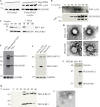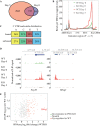The Gag protein PEG10 binds to RNA and regulates trophoblast stem cell lineage specification
- PMID: 30951545
- PMCID: PMC6450627
- DOI: 10.1371/journal.pone.0214110
The Gag protein PEG10 binds to RNA and regulates trophoblast stem cell lineage specification
Abstract
Peg10 (paternally expressed gene 10) is an imprinted gene that is essential for placental development. It is thought to derive from a Ty3-gyspy LTR (long terminal repeat) retrotransposon and retains Gag and Pol-like domains. Here we show that the Gag domain of PEG10 can promote vesicle budding similar to the HIV p24 Gag protein. Expressed in a subset of mouse endocrine organs in addition to the placenta, PEG10 was identified as a substrate of the deubiquitinating enzyme USP9X. Consistent with PEG10 having a critical role in placental development, PEG10-deficient trophoblast stem cells (TSCs) exhibited impaired differentiation into placental lineages. PEG10 expressed in wild-type, differentiating TSCs was bound to many cellular RNAs including Hbegf (Heparin-binding EGF-like growth factor), which is known to play an important role in placentation. Expression of Hbegf was reduced in PEG10-deficient TSCs suggesting that PEG10 might bind to and stabilize RNAs that are critical for normal placental development.
Conflict of interest statement
Authors MA, EV, HB, PL, DSK, RR, SK, JDW, SG, MR, KRA, RJN, MR-G, ZM, KN, and VMD were employees of Genentech. This does not alter our adherence to PLOS ONE policies on sharing data and materials. All reagents generated at Genentech will be available through the Genentech MTA program. There are no patents, products in development or marketed products to declare.
Figures







References
-
- Yoder JA, Walsh CP, Bestor TH. Cytosine methylation and the ecology of intragenomic parasites. Trends Genet. 1997;13: 335–340. - PubMed
Publication types
MeSH terms
Substances
LinkOut - more resources
Full Text Sources
Other Literature Sources
Molecular Biology Databases
Research Materials

